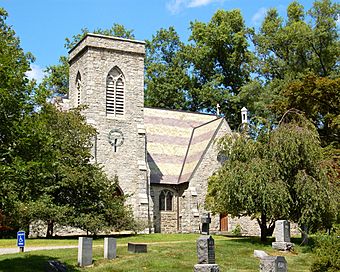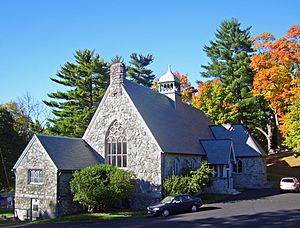St. Philip's Church in the Highlands facts for kids
Quick facts for kids |
|
|
St. Philip's Church
in the Highlands |
|
 |
|
| Location | Garrison, NY |
|---|---|
| Nearest city | Peekskill |
| Built | 1861–1917 |
| Architect | Richard Upjohn |
| Architectural style | Gothic Revival |
| MPS | Hudson Highlands Multiple Resource Area |
| NRHP reference No. | 82005391 |
| Added to NRHP | 1995 |
St. Philip's Church in the Highlands is a historic Episcopal church. It is located in Garrison, a small community in New York. The church is a beautiful stone building designed in the Gothic Revival style. This style looks like old European churches.
The church was designed by Richard Upjohn, who was also a member of the church. It first opened its doors in 1865. St. Philip's Church has a long and interesting history. It has grown and changed along with the Garrison community. The church was added to the National Register of Historic Places in 1995. This means it is recognized as an important historical site.
Contents
History of St. Philip's Church
Early Beginnings: Colonial Times
St. Philip's Church started around 1770. It was part of St. Peter's Church in Peekskill. King George III of Great Britain gave permission for the church to be built. Church leaders, Beverley Robinson and Charles Moore, wanted a new church. They chose an area called Four Corners to serve families living there.
At first, the church met in another building and then in a person's home. Soon, a small wooden chapel was built where the church stands today. A graveyard was also started at the same time. The church might have been named St. Philip's after the Philipse family. They were early landowners in the area.
The American Revolution and Its Impact
The first minister for both churches was Rev. John Doty. He left after a few years because he supported the British King. Many people in the area were starting to support the idea of American independence. Beverley Robinson, one of the church leaders, also supported the British. He helped the British by gathering information.
Because of this, the new government of New York took Robinson's land and home. He left for England after the war and never came back. About half of St. Philip's families also left. The church was not liked by some locals because of its British ties.
There's a famous story that a group of people wanted to burn the church down. But George Washington himself stopped them! He supposedly stood at the door and said, "That, sir, is my church!" Because of this, a stained glass window in the church shows George Washington.
After the Revolution: Rebuilding the Church
After America became independent, the church was empty for a few years. The community slowly began to rebuild. In 1786, William Denning, who took over Robinson's land, helped fix up the church's inside. Six years later, the church got a new minister, Rev. Andrew Fowler. He later helped start the Episcopal Church in South Carolina.
The Garrison Union Free School was built for local families in the 1830s. It still stands today. The church building itself was rebuilt in 1837. By 1840, Garrison and the church had grown a lot. The church became its own independent church, separate from St. Peter's in Peekskill. A house for the minister was built in 1854.
A New and Bigger Church Building
In May 1860, a new pastor named Rev. Charles Frederick Hoffman arrived. A new train line, the Hudson River Railroad, had made Garrison a popular place to live. Many important families from New York City moved there and joined the church. Pastor Hoffman saw that the growing church needed a bigger building.
The church members helped a lot. Henry Belcher donated land for the new church. Others raised $10,000 for its construction. The design came from Richard Upjohn, who was a church member. He was already famous for designing Trinity Church in New York City.
The new church was built of gray granite in the Gothic Revival style. It was finished in 1861 and officially opened and blessed in 1862. Later, a building for horse-drawn carriages and a shed were added. Around 1900, a parish house was built. This building was designed by George E. Harney and William S. Purdy. It is used for church activities.
The 20th Century: Changes and Growth
The early 1900s saw a disagreement within the church. A chapel to the east became a monastery. The monks there later joined the Roman Catholic Church in 1909. St. Philip's Church believed it still owned the land. It took a special law from the state government to settle the dispute.
In 1908, Rev. Edward Clowes Chorley became the new minister. He wrote a two-volume history of St. Philip's Church. While he was there, electricity and gas lighting were added to the church. A boys' choir was also started. Pastor Chorley also oversaw the building of a new minister's house in 1911. Six years later, a house for the church caretaker was built. These buildings are now considered important historical parts of the church property. He also helped start Garrison's volunteer fire department.
Later, a kindergarten was started at the church. It moved to the expanded school in the 1960s. At that time, a nursery school program began. William Reisman became the minister for 27 years. He updated and redecorated many of the church buildings. He added covers to protect the stained-glass windows. He also started classes for adults and updated the church's history book.
Under the next minister, Francis Geer, a new pipe organ was installed. The roof and floor of the parish house were replaced. The parish house is used for many community groups in Garrison. A memorial garden was built north of the parish house. It serves as a welcoming area after church services.


